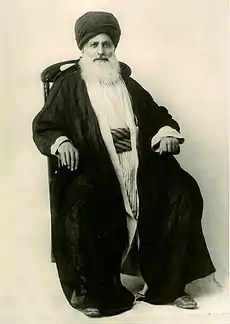Al-Sayyed Mohsen al-Amin
Al-Sayyed Mohsen al-Amin (b.1284/1867-d.1371/1952), also transliterated Muhsin al Amin, was a Shia scholar, biographer, traditionist, and jurist. He was born in Jabal 'Amel, Lebanon. His most important work is A'yan al-Shi'a.[1]
Al-Sayyed Mohsen al-Amin | |
|---|---|
 Grand Ayatollah Al-Sayyed Mohsen al-Amin | |
| Born | 1867 |
| Died | 1952 |
| Region | Iranian Scholar |
| School | Shia Twelver |
Early life and education
Family background
Al-Amin was born in 1867 to a well-known Sayyid family in Jabal 'Amel, Lebanon.He was famous for al-Amin or the trusted one.[2] His father, Abdul al-Karim al-Amili, was a scholar of his time. His father died in Iraq was buried, when he had gone to pilgrimage Iraq.[3] His maternal grandfather was ′Shaykh Muhammad Hussein al Amili al Musawi, was one of the scholars who went to Najaf to education and died there.[3]
Education
Sayyed Mohsen began to study the Qur'an and elementary Arabic grammar at the age of seven under village teacher.[3] Four years later, he learned jurisprudence for three years old under shaykh Musa sharara who returned to Iraq.In 1890, arrangements were made for him to study at the Iraq, Najaf.[3] Finally he was a learned Mujtahid.[4]
Activity
He was among the pioneers of correcting Shia beliefs in modern times. He forbade (Haram) self-injurious. His action made the rallying most of the uneducated villagers against al Amin's calls for reform.[5] By this action, Amin wanted to rationalize religious practices and make them more moral. He was able to expose a more positive image of the Shia thereby.[6]
His children
Published works
- Ayan al-Shia(Arabic: أعيان الشيعة), is one of his works. This work the biographical encyclopedia book[9] and consists of fifty-six volumes.[3]
- Al-husun al-mania fi radd ma awradahu sahib al-manar fi haqq al-shia (Arabic: الحصون المنیعة فی ردّ ما اورده صاحب المنار فی حقّ الشیعة), he explained some of the Shia views in this book.[10]
- Risalat al-tanzih li-a'mal al-shabih (Arabic: رسالة التنزيه لاعمال الشبيه), that was al-Amin's reply to his critics-Sadiq.[4]
- Al-Sahifa al-Sajjadiyya al-khamisa (Fifth), (Arabic: الصحيفة الخامسة السجادية) is the longest version of the Sahifa of al-Sajjad has been published.[11][12]
- Al-Majalis al-saniyya fi manaqib wa-masa'ib al-'itra al-nabawiyya (Arabic: المجالس السنيه في مناقب و مصائب العتره النبويه)[13]
- Iqna' al-la'im ala iqamat al-matam (Arabic: اقناع اللائم علی اقامه المآتم)[13]
- Lawa'ij al-ashjan fi maqtal al-imam Abi Abd Allah al-Husayn (Arabic: لواعج الأشجان في مقتل الإمام إبي عبد الله الحسين ابن علي بن أبي طالب عليه السلام)[13]
- Kashf al-Irtiyab fi Atba' Muhammad b. 'Abd al-Wahhab (Arabic: كشف الإرتياب في أتباع محمد بن عبد الوهاب) [14]
See also
References
- "Al-Sayyid Muhsin al-Amin". WikiShia. December 10, 2014. Retrieved May 2, 2015.
- al-Qurashi, Baqir Sharif. "The Life of Imam Zayn al-'Abidin". Ansariyan Publications - Qum.
- Ajami, Fouad. The Vanished Imam: Musa al Sadr and the Shia of Lebanon. Cornell University Press (August 25, 1987). ISBN 978-0801494161.
- Chalabi, T. The Shi‘is of Jabal ‘Amil and the New Lebanon: Community and Nation-State, 1918–1943. Palgrave Macmillan; 1st edition (February 22, 2006). ISBN 978-1403970282.
- Deeb, Lara. An Enchanted Modern: Gender and Public Piety in Shi'i Lebanon (Princeton Studies in Muslim Politics). Princeton University Press (March 19, 2006). pp. 131–133. ISBN 978-0691124216.
- Alessandro , Naef, Sabahi, Monsutti , Silvia , Farian. The Other Shiites: From the Mediterranean to Central Asia (Welten des Islams/Worlds of Islam/Mondes de l'Islam). Peter Lang AG, Internationaler Verlag der Wissenschaften; 1 edition (August 9, 2007). ISBN 978-3039112890.CS1 maint: multiple names: authors list (link)
- Shaery-Eisenlohr, Roschanack. Shi'ite Lebanon: Transnational Religion and the Making of National Identities (History and Society of the Modern Middle East). Columbia University Press (July 3, 2008). p. 224. ISBN 9780231144261.
- Abisaab, Abisaab, Rula Jurdi, Malek. The Shi'ites of Lebanon: Modernism, Communism, and Hizbullah's Islamists (Middle East Studies Beyond Dominant Paradigms). Syracuse University Press; Reprint edition (January 20, 2017). p. 57. ISBN 978-0815635093.
- Pourjavady, Reza. Philosophy in Qajar Iran. BRILL (November 8, 2018). p. 87. ISBN 978-9004385610.
- Brunner, Rainer. Islamic Ecumenism in the 20th Century: The Azhar and Shiism Between Rapprochement and Restraint (Social, Economic and Political Studies of the Middle East and Asia). Brill (October 28, 2004). ISBN 978-9004125483.
- "Translator's Introduction". al-islam.
- "Al-Sahifa al-Sajjadiyya (The Psalms of Islam)". hajij.
- Shams ad-Din Al-Amili, Shaykh Muhammad Mahdi. "The Revolution of Imam al-Husayn (a)". Muhammadi Trust of Great Britain and Northern Ireland.
- Brockelmann, Carl. History of the Arabic Written Tradition Supplement Volume 3 - i (Handbook of Oriental Studies. Section One: The Near and Middle East / History of the ... Tradition) (English and Arabic Edition). BRILL; Supplement edition (July 19, 2018). ISBN 978-9004335813.
Sources
- Fouad Ajami. The Vanished Imam: Musa Al Sadr and the Shia of Lebanon. Ithaca: Cornell University Press, 1986.